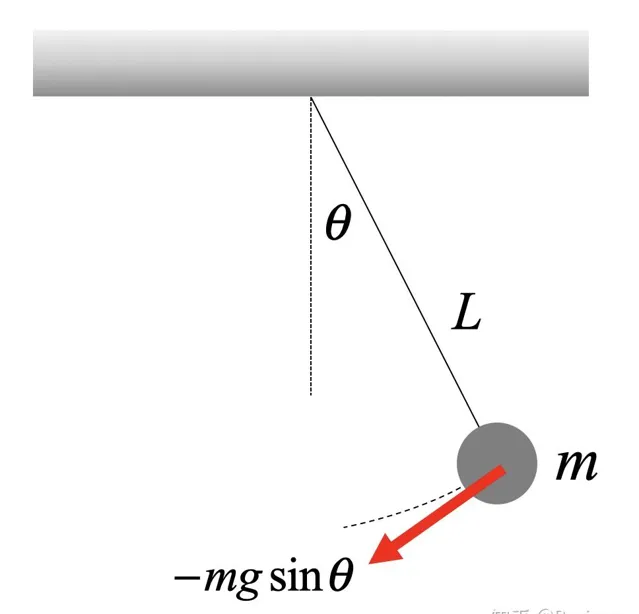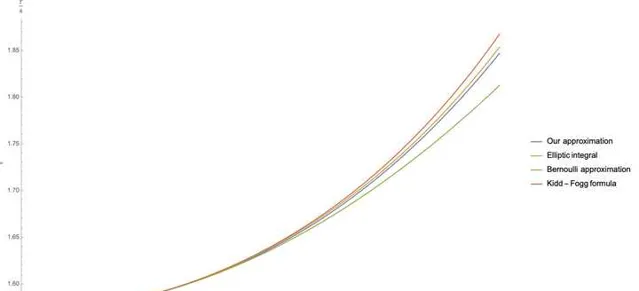谢邀.
与下面的答主同为高中生. 很高兴看到和本人一样喜欢物理理论的学弟!接下来就推一下单摆周期公式.
推导这个公式本质上是建立微分方程并求解. 这里有两种方法列出微分方程:

1.牛顿第二定律: 通过把重力沿着拉力方向和运动轨迹的切线方向分解,得到单摆受到的合力为 -mgsin\theta . 根据牛顿第二定律有 \(m L \frac{d^{2} \theta}{d t^{2}}=-m g \sin \theta\) , 所以微分方程为 \(\frac{d^{2} \theta}{d t^{2}}=-\frac{g}{L} \sin \theta\) .

2.能量守恒定律 :假设没有空气阻力,那么动能和势能之和应该是守恒的. 假设在某一个时刻小球离地面的高度为 h ,此时细绳与竖直方向的夹角为 \theta ,那么小球的重力势能应该是 mgl(1-cos\theta) ,动能应该是 \frac{1}{2}mv^2=\frac{1}{2}m(l\frac{d\theta}{dt})^2=\frac{1}{2}ml^2(\frac{d\theta}{dt})^2 . 能量总和就应该是 E=mgl(1-cos\theta)+\frac{1}{2}ml^2(\frac{d\theta}{dt})^2 . 由于能量守恒,所以 \frac{dE}{dt}=0 , 即 mglsin\theta(\frac{d\theta}{dt})+ml^2\frac{d^2\theta}{dt^2} . 最后得到的也是 \(\frac{d^{2} \theta}{d t^{2}}=-\frac{g}{l} \sin \theta\) .
现在得到了\(\frac{d^{2} \theta}{d t^{2}}=-\frac{g}{l} \sin \theta\) 这个公式,可以做一波近似,前面的答主已经说的很好了. 这里来推导一下不做近似的公式,需要一点技巧.
\(\frac{d^{2} \theta}{d t^{2}}=\frac{d}{d t} \frac{d \theta}{d t}=\frac{d \omega}{d t}=\frac{d \omega}{d \theta} \frac{d \theta}{d t}=\omega \frac{d \omega}{d \theta}\)
于是这个方程现在就变成了 \omega\frac{d\omega}{d\theta}=-\frac{g}{l}sin\theta . 立刻看出这个式子是可以分离变量的. 于是分离变量并且等式两边积分后得到 \(\omega=\sqrt{\frac{2 g}{L}\left(\cos \theta-\cos \theta_{0}\right)}=\sqrt{\frac{4 g}{L}\left(\sin ^{2} \frac{\theta_{0}}{2}-\sin ^{2} \frac{\theta}{2}\right)}\) . 其中 \theta_{0} 是初始角度.
由于 \(\int d t=\int \frac{d \theta}{\omega}\) , 得到 \(\frac{T}{4}=\int_{3 T / 4}^{T} d t=\frac{1}{2} \sqrt{\frac{L}{g}} \int_{0}^{\theta_{0}} \frac{d \theta}{\sqrt{\sin ^{2}\left(\theta_{0} / 2\right)-\sin ^{2}(\theta / 2)}}\) .
现在需要对这个积分稍微做一下变换. 令 \begin{equation} \sin \alpha=\frac{\sin (\theta / 2)}{\sin \left(\theta_{0} / 2\right)} \end{equation} , 现在关注积分的部分:
\begin{equation} \int_{0}^{\theta_{2}} \frac{d \theta}{\sqrt{\sin ^{2} \frac{\theta_{0}}{2}-\sin ^{2} \frac{\theta}{2}}}=2 \int_{0}^{\pi / 2} \frac{d \alpha}{\sqrt{1-\sin ^{2} \frac{\theta_{0}}{2} \sin ^{2} \alpha}} \end{equation} .
所以最后得到 \begin{equation} \frac{T}{4}=\sqrt{\frac{L}{g}} \int_{0}^{\pi / 2} \frac{d \alpha}{\sqrt{1-k^{2} \sin ^{2} \alpha}}, k^{2}=\sin ^{2} \frac{\theta_{0}}{2} \end{equation} .
其实到这里已经差不多了. 这个积分叫做第一类椭圆积分,解析解是雅可比椭圆函数. 说白了就是物理学家解不出来然后就自己定义了这么个东西. 现在到这一步硬推已经没什么意义了,但是如果感兴趣还是可以继续往下推导. 为了计算这个积分,需要引入以下两个引理:
首先给出下面两个定理作为铺垫:
定理1 如果 k 是实数,并且 \left| x \right|<1 ,那么 \[{(1 + x)^k} = 1 + kx + \frac{{k(k - 1)}}{{2!}}{x^2} + \frac{{k(k - 1)(k - 2)}}{{3!}}{x^3} + ...\]该定理被称为广义二项式定理. 一些人习惯记为 \[{(1 + x)^k} = \sum\limits_{n = 0}^\infty {\left( \begin{array}{l} k\\ n \end{array} \right){x^n}} \] ,不过我个人习惯用泰勒展开记忆: \[f(x) = f(0) + f'(0)x + \frac{{f''(0)}}{{2!}}{x^2} + \frac{{f'''(0)}}{{3!}}{x^3} + ...\] 之所以是广义,就是因为此时 k 不仅仅可以是正整数,可以是任意实数.在上面的积分中,被积函数的幂 k=-\frac{1}{2} .
定理2 \[\int_0^{\pi /2} {{{\sin }^{2n}}xdx = \frac{{1 \cdot 3 \cdot 5 \cdot \cdot \cdot \cdot \cdot \cdot (2n - 1)}}{{2 \cdot 4 \cdot 6 \cdot \cdot \cdot \cdot \cdot \cdot 2n}}\frac{\pi }{2}} \]下面简单证明一下这个定理. 首先设 \[u = {\sin ^{2n - 1}}x\] , \[dv = \sin xdx\] .则 \[du = (2n - 1){\sin ^{2n - 2}}x\cos xdx\] , \[v = - \cos x\] .分部积分得:
\[\int_0^{\pi /2} {{{\sin }^{2n}}xdx} = [{\sin ^{2n - 1}}x( - \cos x)]_0^{\pi /2} - \int_0^{\pi /2} {(2n - 1){{\sin }^{2n - 2}}x\cos x( - \cos x)dx} \]
\[ = (2n - 1)\int_0^{\pi /2} {{{\sin }^{2n - 2}}x{{\cos }^2}xdx} \]
\[ = (2n - 1)[\int_0^{\pi /2} {{{\sin }^{2n - 2}}xdx - } \int_0^{\pi /2} {{{\sin }^{2n}}xdx]} \]
不妨设 \[\int_0^{\pi /2} {{{\sin }^{2n}}xdx} = I\] ,对等式整理得到 \[I = \frac{{2n - 1}}{{2n}}\int_0^{\pi /2} {{{\sin }^{2n - 2}}xdx} \]
那么很显然对等式右边的积分进行相同的操作后会得出 \[\int_0^{\pi /2} {{{\sin }^{2n - 2}}xdx} = \frac{{2n - 3}}{{2n - 2}}\int_0^{\pi /2} {{{\sin }^{2n - 4}}xdx} \] ,如此一直递归下去后得:
\[I = \frac{{(2n - 1)(2n - 3) \cdot \cdot \cdot \cdot \cdot \cdot 5 \cdot 3}}{{(2n)(2n - 2) \cdot \cdot \cdot \cdot \cdot \cdot 6 \cdot 4}}\int_0^{\pi /2} {{{\sin }^2}xdx} \]
\[ = \frac{{(2n - 1)(2n - 3) \cdot \cdot \cdot \cdot \cdot \cdot 5 \cdot 3}}{{(2n)(2n - 2) \cdot \cdot \cdot \cdot \cdot \cdot 6 \cdot 4}}\int_0^{\pi /2} {\frac{{1 + \cos 2x}}{2}dx} \]
\[\frac{{(2n - 1)(2n - 3) \cdot \cdot \cdot \cdot \cdot \cdot 5 \cdot 3 \cdot 1}}{{(2n) \cdot (2n - 2) \cdot \cdot \cdot \cdot \cdot \cdot 6 \cdot 4 \cdot 2}}\frac{\pi }{2}\]
言归正传,接下来我们对被积函数进行展开,根据定理1:
\[{(1 - {k^2}{\sin ^2}x )^{ - 1/2}} = 1 - \frac{1}{2}( - {k^2}{\sin ^2}x) + \frac{{\frac{1}{2} \cdot \frac{3}{2}}}{{2!}}{( - {k^2}{\sin ^2}x)^2} - \frac{{\frac{1}{2} \cdot \frac{3}{2} \cdot \frac{5}{2}}}{{3!}}{( - {k^2}{\sin ^2}x)^3} + ....\]
\[ = 1 + (\frac{1}{2}){k^2}{\sin ^2}x + (\frac{{1 \cdot 3}}{{2 \cdot 4}}){k^4}{\sin ^4}x + (\frac{{1 \cdot 3 \cdot 5}}{{2 \cdot 4 \cdot 6}}){k^6}{\sin ^6}x...\]
对被积函数逐项积分,同时利用定理2得:
\[\int_0^{\pi /2} {\frac{{dx}}{{\sqrt {1 - {k^2}{{\sin }^2}x} }} = \frac{\pi }{2} + (\frac{1}{2})(\frac{1}{2}\frac{\pi }{2}){k^2} + (\frac{{1 \cdot 3}}{{2 \cdot 4}})(\frac{{1 \cdot 3}}{{2 \cdot 4}}\frac{\pi }{2}){k^4} + (\frac{{1 \cdot 3 \cdot 5}}{{2 \cdot 4 \cdot 6}})(\frac{{1 \cdot 3 \cdot 5}}{{2 \cdot 4 \cdot 6}}\frac{\pi }{2}){k^6} + ....} \]
\[ = \frac{\pi }{2}[1 + (\frac{{{1^2}}}{{{2^2}}}){k^2} + (\frac{{{1^2} \cdot {3^2}}}{{{2^2} \cdot {4^2}}}){k^4} + (\frac{{{1^2} \cdot {3^2} \cdot {5^2}}}{{{2^2} \cdot {4^2} \cdot {6^2}}}){k^6} + ...]\]
注意这里将 \alpha 换成了 x ,为了和前面保持一致
故周期为
\[T = 2\pi \sqrt {\frac{L}{g}} [1 + (\frac{{{1^2}}}{{{2^2}}}){k^2} + (\frac{{{1^2} \cdot {3^2}}}{{{2^2} \cdot {4^2}}}){k^4} + (\frac{{{1^2} \cdot {3^2} \cdot {5^2}}}{{{2^2} \cdot {4^2} \cdot {6^2}}}){k^6} + ...]\]
故当 k 很小时,周期可以近似写成 \[T = 2\pi \sqrt {\frac{L}{g}} \] . 实际上一个更好的近似是 \[T = 2\pi \sqrt {\frac{L}{g}} (1 + \frac{1}{4}{k^2})\]
这里我们来仔细研究一下上面的无穷级数.注意到从级数的第二项开始,每一项的系数都小于 \frac{1}{4} ,所以不妨把其与下面这个等比级数比较一下:
\[1 + \sum\limits_{n = 1}^\infty {\frac{1}{4}{k^{2n}}} = 1 + \frac{{{k^2}/4}}{{1 - {k^2}}} = \frac{{4 - 3{k^2}}}{{4 - 4{k^2}}}\]
很显然该级数大于上面的周期级数,所以我们可以进行下面的数值估计:
\[2\pi \sqrt {\frac{L}{g}} (1 + \frac{1}{4}{k^2}) \le T \le 2\pi \sqrt {\frac{L}{g}} \frac{{4 - 3{k^2}}}{{4 - 4{k^2}}}\]
说到近似,实际上物理学家得出了两个非常著名的单摆周期近似公式:
\begin{equation} T_{B} / 4=\frac{\pi}{2}\left(1+\frac{\theta_{0}^{2}}{16}\right) \end{equation}
-伯努利提出的公式,实际上就是上面推到的结果再次级数展开后得到的近似.
\begin{equation} T_{K D} / 4=\frac{\pi}{2} \frac{1}{\sqrt{\cos \left(\frac{\theta_{0}}{2}\right)}} \end{equation}
-Kidd-Fog提出的公式,以简洁优雅著称,精确度也是相当的高.
其实我自己也曾经想过这个问题,于是将最开始提到的微分方程全部幂级数展开求得了一个公式,近似结果是: \begin{equation} T / 4=1.57+0.094 \theta_{0}^{2}+0.007 \theta_{0}^{4} \end{equation} . 在展开项同样多的情况下,精确度对比如下:

如果感兴趣可以查看我的专栏:











